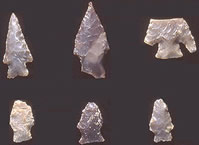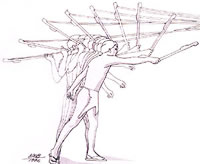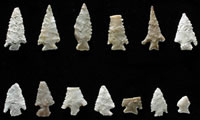
Dart tips and arrowpoints found on floor
of House 1 suggest that two different weapons systems were
used by the rancheria folk. Photo by Milton Bell.
Click images to enlarge
|

Variety of dart points found at the site.
As tips on a light spear or dart, these likely were propelled
by an atlatl. Photo by Milton Bell.
|
|
The bow and arrow was a relatively new weapon system
in central Texas a thousand years ago when the Graham/Applegate
rancheria was inhabited. It had come into use only a few centuries
earlier, around A.D. 700, perhaps brought into the region by new
migrants, or more likely, simply adopted by the indigenous population.
The bow and arrow was spreading across much of North America around
this time, replacing the older atlatl and dart as the principal
weapon for hunting large game and for warfare. While some aboriginal
groups continued to use both weapon technologies, archeological
evidence in central Texas seems to point to a rapid and complete
replacement of the atlatl and dart by the bow and arrow.
An interesting revelation from the excavations at
the Graham/Applegate site is that the hunters who resided in the
rancheria were apparently using both kinds of projectile weapons:
the atlatl and dart, as well as the bow and arrow. The most convincing
evidence for this was uncovered on the floor of House 1, the largest
structure at the site. A small stone point that once tipped an arrow
was found near two heavier points that probably once armed light
spears (darts) that would have been thrown with the atlatl.
The atlatl (or spear thrower) is a short stick, two
feet or so in length with a small prong or hook at one end, which
was used to throw a light spear or dart. Although simple in design,
it is an extremely effective weapon, allowing the user to throw
a spear much farther—the length of a football field—than
he could without it and with the force necessary to bring down large
game . The atlatl is a very ancient weapon—no one really knows
how old, but it was in use in the Old World at least 20,000 years
ago—and there is a strong likelihood that the earliest people
to enter the New World were equipped with it.
On the other hand, the bow and arrow came into use
relatively late in the Americas. This weaponry was known to the
Late Paleolithic people of Europe over 10,000 years ago, but it
appears that the native peoples of the New World only took it up
during the last two thousand years. Perhaps the bow and arrow was
independently invented somewhere in North America, or, more likely,
the technology spread or diffused from the Old World. Unfortunately,
archeological evidence documenting the spread of the bow and arrow
and the atlatl and dart is largely lacking due to the fact that
these weapons were made primarily of wood and other perishable materials.
The history and diffusion of these technologies is
traced almost entirely by the stone points used to tip the arrows
and darts, artifacts that survive to become part of the archeological
record. The larger, heavier dart points were shaped to a large degree
by percussion flaking, while the lighter, thin arrow points were
mostly pressure flaked. Because they are so small and light, stone
arrow points are often called "bird points" by collectors
but, in fact, they were used to hunt the same kind of animals as
the larger points hafted to darts—deer, antelope, even bison.
Only under extraordinary conditions have prehistoric artifacts made
from perishable materials survived to the present day in the relatively
humid climate of central Texas.
No prehistoric bows are known to have been found
in this region, but in a rockshelter near Waco, several fragments
of prehistoric arrows were recovered during excavations in the early
1960s. They date to a slightly more recent time than the Austin
phase but perhaps offer an indication of the kinds of arrows used
by the hunters of the Graham-Applegate rancheria. The main shafts
of the arrows were made from cane, and because of their delicacy
(and to add forward weight), the front of the shaft was fitted with
a short foreshaft of hard wood, the tip of which was notched for
the stone arrow point. Virtually all prehistoric arrows that have
been found in the United States (mostly in dry caves and rockshelters
of the arid Southwest) are made of cane and therefore are extremely
light compared to most modern arrows. This explains why such light-weight
stone points were attached to them.
|

Artist's conception of how a dart or spear
would have been delivered using an atlatl. Drawing by Ken
Brown.
|

Small, light-weight points, such as these
known as Scallorn from the Graham-Applegate site, tipped arrows
used in the new weaponry system adopted around A.D. 700. Forcefully
propelled from a bow, even the smallest points could fell
game such as deer and bison. The specimen shown at bottom
right is smaller than a dime. Photo by Milton Bell.
|
|